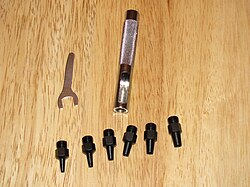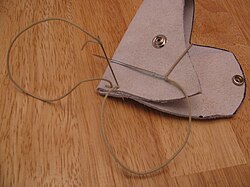Difference between revisions of "AY Honors/Leather Craft - Advanced/Answer Key"
| Line 21: | Line 21: | ||
[[File:Saddle stitch.jpg|thumb|200px|Saddle stitching]] | [[File:Saddle stitch.jpg|thumb|200px|Saddle stitching]] | ||
In saddle stitching, two needles are used, one on each end of the thread. One needle is passed through the first hole in the piece and pulled through until there is an equal length of thread on both sides of the hole. Then both needles are passed through the next hole (one at a time). | In saddle stitching, two needles are used, one on each end of the thread. One needle is passed through the first hole in the piece and pulled through until there is an equal length of thread on both sides of the hole. Then both needles are passed through the next hole (one at a time). | ||
| + | {{clear}} | ||
===Lacing=== | ===Lacing=== | ||
Revision as of 23:59, 25 February 2009
1. Have the Leather Craft Honor.
2. Show how to punch holes, set snaps, do saddle stitching, and do two types of lacing.
Punching Holes
There are basically two types of leather punches: the rotary punch and the hollow punch.
- Rotary punch
- The rotary punch looks like a regular paper hole punch, except that it has a "spur" on the end allowing the user to select the size of the hole to be made. This type of punch should not be used when making holes for lacing or sewing. It is more suited to punching holes for a belt, a wrist band, or a snap.
- Hollow punch
- A hollow punch looks a bit like a small pipe with a sharpened end. The sharpened end is held against the leather and the other end is then struck with a mallet. The leather should be backed by a piece of soft wood. A small leather disc is removed from the piece and goes up into the punch. The punch usually features a slot in the side so that these discs can be removed.
Setting Snaps
Before a snap can be set, a hole must be punched in the two pieces of leather where the snaps will go. It is best to punch both pieces at the same time so that the holes (and thus the two parts of the snap) will line up. Choose a punch that will make a hole which will provide a snug fit for the snap.
Once the holes are punched, insert the finished side of the snap into the hole which will be most visible on the finished piece.
Setting the snap requires the use of a two-part tool specially designed for this purpose. The first part of the tool is a small anvil. The finished side of the snap is placed in the concave surface of the anvil. Note that the snap should still be positioned in the hole punched earlier, and the leather should be situated with its finished-side down. The other half of the snap is then placed on the first half, and the second part of the tool is brought to bear. This part of the tool is similar to a punch, but it is designed to mushroom over the first half of the snap, forming a rivet joint. The tip of the tool is placed on the shaft of the bottom half of the snap, and then struck sharply with a mallet. Repeated blows may be necessary to form a tight rivet joint.
Setting the other half of the snap is done in the same way.
Saddle Stitching
In saddle stitching, two needles are used, one on each end of the thread. One needle is passed through the first hole in the piece and pulled through until there is an equal length of thread on both sides of the hole. Then both needles are passed through the next hole (one at a time).
Lacing
3. Make a sheath for a hatchet, knife, or ax.
4. Complete a figure-carved belt, doing your own tooling.
The amount of leather you will need for this will depend on the waist-size of the intended recipient of the belt. The width should be roughly 2.5cm![]() , but some variability here is OK - just make sure it will fit through the belt loops.
, but some variability here is OK - just make sure it will fit through the belt loops.
The length of the belt should be equal to the waist size of the intended wearer plus about 15cm![]() . Ten centimeters
. Ten centimeters![]() of this excess will be allowed for the end that goes through the buckle, and the remainder will be for the end that attaches permanently to the buckle. Once the belt has been cut out, you can tool it using the standard means. It is not necessary (or even desired sometimes) to tool the entire length of the belt.
of this excess will be allowed for the end that goes through the buckle, and the remainder will be for the end that attaches permanently to the buckle. Once the belt has been cut out, you can tool it using the standard means. It is not necessary (or even desired sometimes) to tool the entire length of the belt.
When tooling has been completed, the belt can be dyed. Finally, the holes should be punched and the buckle attached.
If you prefer, you could make a guitar strap instead.
5. From your own design, cut from leather, tool, punch, and lace a project such as a case, purse, bag, or an equivalent.
There are many items you use in everyday life and as a Pathfinder that can benefit from having a carrying case. Here are a few such things:
- Bible
- Binoculars
- MP3 player
- Cell phone
- Eyeglasses
- Toiletries
- Flint and steel
- Notebook
- Daily planner
- Pathfinder pins
- Laptop Computer
- PDA
- Camera
You may prefer to make a garment or accessory:
- Vest
- Hat
- Gloves
- Moccasins
6. Show six leather items you have made.
You should already have made:
- a sheath (knife, hatchet, or ax)
- a belt
- an item of your own design
- an item you made when completing requirement 4 of the standard level of the Leather Craft honor.
You will therefore only need to make two more items to meet this requirement. You can make items of your own design, or make items that someone else has already designed, or one of each. It's up to you.


